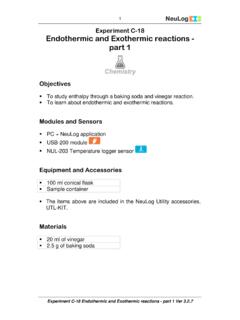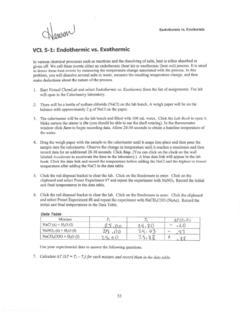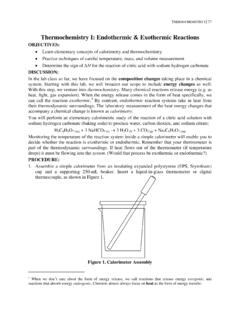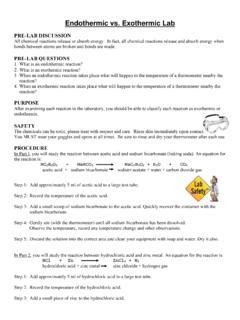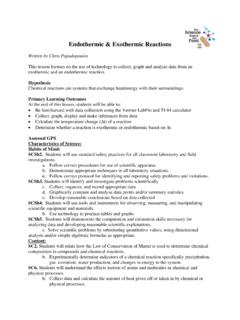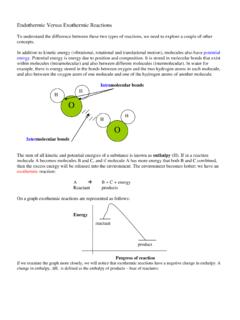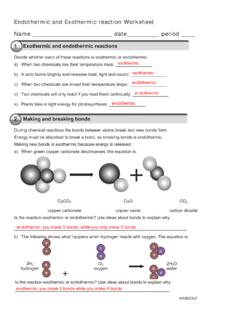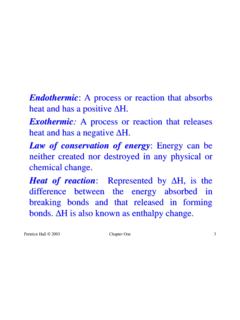Transcription of Endothermic and Exothermic reactions - NeuLog
1 Experiment C-18 Endothermic and Exothermic reactions - part 1 Ver 1 Experiment C-18 Endothermic and Exothermic reactions - part 1 Objectives To study enthalpy through a baking soda and vinegar reaction. To learn about Endothermic and Exothermic reactions . Modules and Sensors PC + NeuLog application USB-200 module NUL-203 Temperature logger sensor Equipment and Accessories 100 ml conical flask Sample container The items above are included in the NeuLog Utility accessories, UTL-KIT. Materials 20 ml of vinegar g of baking soda Experiment C-18 Endothermic and Exothermic reactions - part 1 Ver 2 Introduction In a chemical reaction, reactant molecules bonds break and new bonds are formed within the product molecules.
2 In general, energy is required in order to break the reactant molecules bonds and energy is released by bond formation in the products. An Exothermic reaction occurs when the energy required in order to break the reactant molecules bonds is less than the energy released by bond formation in the products, therefore energy is released during the reaction. Experiment C-18 Endothermic and Exothermic reactions - part 1 Ver 3 An Endothermic reaction occurs when the energy required in order to break the reactant molecules bonds is higher than the energy released by bond formation in the products, therefore energy is absorbed during the reaction.
3 The difference in energy between the reactants and the products is known as the enthalpy change of the system ( H). The enthalpy change for a reaction can be calculated by this equation: H = H(products) - H(reactants) In Exothermic reactions , the enthalpy of the products is less that the enthalpy of the reactants due to energy release, therefore H is negative. In Endothermic reactions , the enthalpy of the products is higher than the enthalpy of the reactants due to energy absorption, therefore H is positive. In this experiment, you will study the reaction of baking soda and vinegar and decide whether it is an Exothermic or Endothermic reaction.
4 Baking soda is sodium bicarbonate (NaHCO3) and the key ingredient of vinegar is acetic acid (CH3 COOH). When they react together they produce carbon dioxide, water and sodium acetate. )()()()()(32233aqCOONaCHlOHgCOsNaHCOaqCO OHCH Experiment C-18 Endothermic and Exothermic reactions - part 1 Ver 4 Procedure Experiment setup Caution: It is recommended to wear personal protective equipment. Material Safety Data Sheets (MSDS) are available online. 1. Set up the experiment as shown in the picture below. 2. Make sure you have a conical flask with 20 ml of vinegar, and a sample container with g of baking soda (approximately half a teaspoon).
5 3. Insert the temperature sensor's probe in the conical flask. 4. Open the sample container. Experiment C-18 Endothermic and Exothermic reactions - part 1 Ver 5 Sensor setup 5. Connect the USB-200 module to the PC. 6. Check that the temperature sensor is connected to the USB-200 module. Note: The following application functions are explained in short. It is recommended to practice the NeuLog application functions (as described in the user manual) beforehand. 7. Run the NeuLog application and check that the temperature sensor is identified. Settings 8.
6 Click on the On-line Experiment icon in the NeuLog main icon bar. 9. 10. Click on the Experiment Setup icon and set the: Experiment duration to 2 minutes Sampling rate to 60 per minute Experiment C-18 Endothermic and Exothermic reactions - part 1 Ver 6 Testing and measurements 11. Wait until the temperature stabilizes. 12. Click on the Run Experiment icon to start the measurement. 13. Wait for about 10 seconds and then slowly add the g of baking soda to the vinegar. Shake the flask from time to time. 14. Observe the changes in the temperature (stop the measurement if the value has stabilized).
7 15. When the measurement is over, touch the flask, can you feel the temperature difference? 17. Click on the Zoom fit icon (or click on the icon and locate the mouse cursor at a point above the graph and press its left button; keep it pressed and create a rectangle that includes the whole graph). 16. Your graph should be similar to the following: 18. Save your graph. Baking soda was added Experiment C-18 Endothermic and Exothermic reactions - part 1 Ver 7 19. In order to calculate the temperature change, click on the Select Zone icon and select the part between the beginning and ending of the measurement.
8 17. Look at the data at the bottom of the graph, we can see that the temperature dropped from C to C in the sample measurement. The temperature change was C. Is the reaction Exothermic or Endothermic ? Is the energy released or absorbed from the surrounding? Summary questions 1. Is the H positive or negative for this reaction? Explain. 2. Name three uses of Endothermic and/or Exothermic reactions . 3. Did you see bubbles after adding the baking soda? Why do you think they formed?
